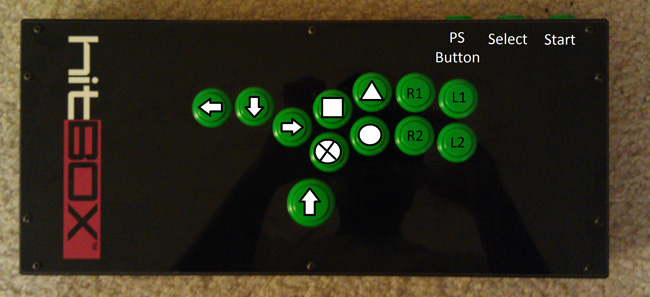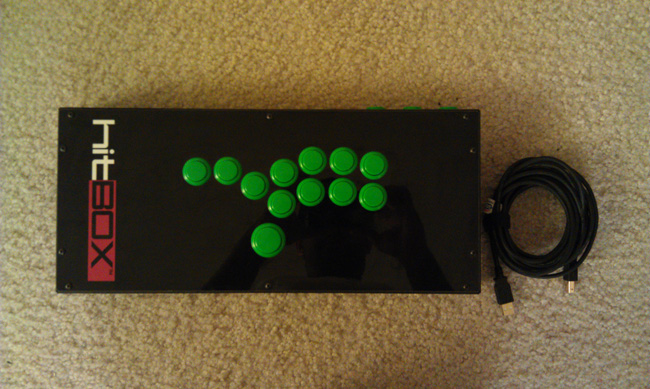
Hardware Review: The Hit Box Arcade Stick
Posted by Vivas on October 28th, 2011 | 0 Comments | Tags: Arcana Heart 3 , Hitbox
Wow the first hardware review on the site! Excited? You know we are. Today we’re going to look at the Hit Box Arcade Joystick an arcade stick that I was recently interested in primarily because of the resurgence in fighting games. Now that developers are bringing out downloadable fighting games like Street Fighter 3: Third Strike Online (aka Online Edition) and Arcana Heart 3 it makes sense that we would talk about some gaming peripherals that could have a significant affect on this genre.
Of course the Hit Box is not a typical arcade joystick. In fact, looking at it there isn’t a joystick to be found anywhere on its surface. There are three front facing buttons and twelve face buttons. This stickless design for the Hit Box is what makes it so unique. The four buttons arranged in an arc on the left side are mapped to the four directions: up, down, left, and right. The other eight face buttons map to all of the other buttons present on a standard Dual Shock 3 gamepad. Meanwhile, the three front facing buttons map to the PS button, select, and start. A diagram showing the default button mapping for the stick can be seen below.

In terms of hardware specs, the Hit Box has dimensions of 16″ x 7″ x 2″ which is actually an increase from the earlier model which was 12″ x 6″ x 2″. While the new units are bigger, it does make it easier to rest the controller on your lap. Plus since you won’t be moving a stick back and forth, the Hit Box doesn’t jump around at all since the force for button presses is directed downward. The face buttons also come in a variety of colors and the box itself comes in a polished black finish for the PS3 version. The unit also features a 15′ USB cable which will provide ample slack for just about any audio-visual home setup. New to this particular model is the fact that the USB cable also comes with a Velcro tie to aid with storage. Also, despite the size, the system is very light, and fits into most bags for easy portability to tournaments.
While many would question the removal of the joystick, the reality is that having four directional buttons gives the player a far faster input speed and an increased input efficiency. However some would argue that this kind of setup would only be amenable to games like Mortal Kombat where there are no half circles or quarter circle based inputs in order to perform super moves. But stop and think for a second. A classic quarter circle movement from Street Fighter is Ryu’s Hadouken Fireball. The button combo for the move is down, down-forward, forward and a punch button. But in reality you only need two directions to define the arc for a super move. So you can achieve the same result by pressing down, forward + punch. Half circles can be broken down in the same way, but instead of 2 directions a half circle is actually 3 directions. Thinking of the controls in this fashion shows that really all fighting games have a unified control scheme which is where the creators of the Hit Box have struck gold.
As a result of the radical redesign of the very concept of an arcade stick in its entirety, Hit Box has a range of capabilities that have been documented for franchises such as Mortal Kombat, Street Fighter, and Marvel vs. Capcom. However, one area where the stick hasn’t really been tested is in a fully anime style, Japanese fighting game. So in order to test the Hit Box and do something novel with it at the same time, I decided I would give Arcana Heart 3 a second look with the Hit Box instead of a game pad. In the interest of full disclosure, I read through the entire Silconera guide to AH3 so that I could give myself some kind of tutorial for the game. The results of this experiment were nothing short of astounding.

The interesting thing about AH3‘s control scheme is that there are designated buttons for throwing, breaking combos, and a launcher for juggles. Sadly the game does not mention this in the control menu as ‘Throw’, ‘Breaker’, or ‘Launcher’ but rather as two button combinations which are also redundantly mapped to single buttons. Playing the game with a DS3 controller while knowing this information definitely helped my game, but I still found combos tough to perform on a standard D-Pad. The problem that arose very quickly was when I would try to hit back or forward I found myself jumping. This problem is further compounded when trying to pull off super moves in which quick back and forward directional presses maybe required in tandem.
However, the Hit Box remedies this problem by isolating the directions to a single button press. The increase in precision makes performing supers and specials much easier. Moreover, the increased efficiency with which these moves can be pulled off allows a player to take advantage of more situations where their opponent maybe vulnerable. The stick also provides far more accuracy for juggle combos as a result of the increased control precision. It’s much easier to time homing attacks and time double jumps to keep an opponent in the air. Also the input speed of the Hit Box allows cancels to be performed with relative ease allowing a skilled player to take advantage of the rather deep fighting system present within AH3 as any move can be cancelled into or out of. This can make for some great mind games and mix-up combos within a match to keep an opponent guessing.
Shutting down an opponent’s super moves and specials also becomes much easier since the input timing on the launcher can cancel a charge move and, in some cases it can even override an opponent’s super move or combo. In testing the stick with Chris in a few online fights, I found that pressing the launcher just as he reached me, when I had the Hit Box in hand, allowed me to catch him and juggle him causing him to waste his meter and opening him up for a huge punish. Normally, the game would give priority to his super move and would detect that I had been tagged before going into Chris’s character’s animation for the super. In this case, the game gave me input priority probably owing to how fast the button press was detected prior to being hit with the super. In short, it’s something that required much more forward thinking with a DS3 while with the Hit Box it just felt reflexive.
Overall the Hit Box is a fantastic piece of hardware that can aid even the most expert of fighting game enthusiasts. In keeping with its winning streak in other fighting games, it works incredibly well with AH3. Hit Box is a young company that is eager to make its mark amongst the Mad Catzs and PDPs of the world. Their product certainly speaks for itself. Also when compared to the price of traditional joysticks the decision to buy one is also made easier. The Hit Box costs $159.99 normally with an $18 charge for shipping. Meanwhile, a Mad Catz TE fight stick (considered to be the cream of the fighting peripheral crop) will cost you around $140 on Amazon with an $11 shipping charge. However, considering the standard for product quality and crisp controls the price difference is arguably pretty negligible. The controller also has a bit of a learning curve as players will have to wrap their minds around not having a stick, but after about a week of play-testing my confidence with the stick improved tremendously. So whether you’re a fighting game novice or a EVO contender the Hit Box is a fantastic piece of hardware that works well with Arcana Heart 3 and indeed any other fighting game on the market.
A Hit Box was purchased for review purposes. For more info on our review policy click here.






